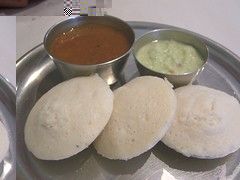August 16, 2009 ☼ Arthashastra ☼ Aside ☼ food ☼ globalisation ☼ history ☼ trade
Sunday Levity: Foreign origins of the South Indian breakfast
Most people—most of all South Indians—react to this with shock and denial. Some go on and come to terms with it.
Well, the fact is the idli—a dish that is almost synonymous with South India—was probably an import from what is now Indonesia (and what was then the Sri Vijaya empire). This little morsel comes from the late K Thammu Achaya, food scientist and historian. As Vikram Doctor writes:
It’s…surprising then to read K T Achaya’s theory that idlis are a relatively recent introduction to India. He notes that the word might derive from ‘iddalige’, first mentioned in a Kannada work of 920 AD, but the indications are that this was made from an urad dhal batter only.
The Sanskrit Manasollasa of 1130 AD has ‘iddarika’, but again made from urad dhal flour only. Tamil apparently only first mentions ‘itali’ in the 17th century. All these references, Achaya notes, leave out three key aspects of idlis: “the use of rice grits along with urad dhal; the long fermentation of the mix; and the steaming of the batter to fluffiness.”
Only after 1250 AD are there references to what seem to be idlis as we know them. Achaya’s contention is that this absence from the historical record could mean that idlis are an imported concept — perhaps from Indonesia which has a long tradition of fermented products, like tempeh (fermented soy cakes), kecap (from where we get ketchup) or something called kedli, which Achaya says, is like an idli. This is plausible enough given the many links between Southeast Asia and South India, through Hindu rulers and traders. [ET]D Balasubramanian had a good report on Dr Achaya’s works in The Hindu and there’s a little discussion on the subject over at Manjunath & Co’s blog. Although two of Dr Achaya’s most well-regarded works on Indian food seem to be out of print, his last book, The Story of our Food is available.
Meanwhile, the chillies in the chutney and the tomatoes in the sambar came from the Americas with the Europeans.
That’s not all though. It was Baba Budan, a 17th century Sufi from Karnataka who broke the Arabian monopoly on coffee. Legend has it that:
On pilgrimage to Mecca in the middle 1600s, Baba Budan, a revered holy man from India, discovered for himself the wonders of coffee. In his zeal to share what he’d found with his fellows at home, he smuggled seven coffee beans out of Arabia, wrapped around his belly. On his return home, he planted the beans in the hills of Mysore, India, and nurtured the young coffee bushes that resulted. Coffee flourished in the hills of India — hills now named after Baba Budan.
In short order, enterprising Dutch traders bought some of these coffee plants, and shipped them to faraway colonies in Indonesia and Ceylon. The Arabian monopoly of the coffee trade was over, and the Western world was waking up to a new aroma… one that would play a fateful role in Europe, and beyond. [Green Mountain Coffee]Baba Budan gave his name to a hill in Karnataka, and more recently, spread his seeds wide—to cafes in Cincinatti and Melbourne.
Tea? Okay, it was probably grown and consumed in India long before the British came, but you don’t have to be Aakar Patel to accept that tea as we drink it today is largely a gift of British colonial rule.
So there’s more than one ‘foreign hand’ in the ‘traditional’ South Indian breakfast. The sugar that goes into it though–we have on Dr Achaya’s authority—is an Indian invention.
Tailpiece: Mr Balasubramanian notes that “Dr Achaya points out how in 300 BC, the Arthasastra described the balanced meal of a gentleman as 500 g rice, 125 g dal, 56 g oil and salt..(and this) is the same in essentials as the recommended balanced diet that the Indian Council of Medical Research laid down in 1987 AD.”
K Subrahmanyam on Admiral Mehta’s speech Next
Which voice came from the mouthpiece?
© Copyright 2003-2024. Nitin Pai. All Rights Reserved.
